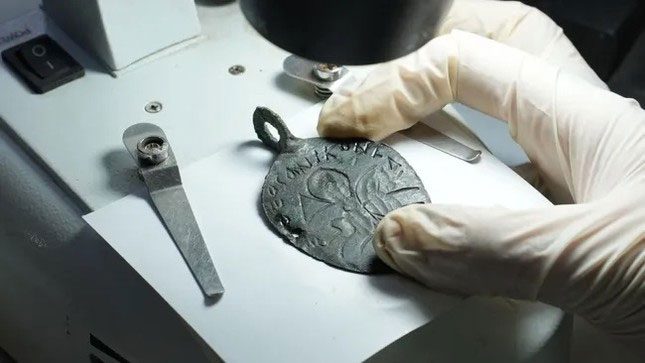Archaeologists in Turkey have discovered a rare fifth-century Christian pendant depicting King Solomon riding a horse and slaying a demon. This pendant is the only one of its kind found in Anatolia, an area that encompasses much of modern-day Turkey.
Both sides of the bronze pendant feature inscriptions in ancient Greek. The inscription on the side depicting King Solomon translates to “Our Lord has defeated evil”, while the other side lists the names of four angels: Azrael, Gabriel, Michael, and Israfil.

The fifth-century amulet “is a symbol of religion and power.” (Photo: Karabük University)
“This is a symbol of religion and power,” said Ersin Çelikbaş, an archaeologist at Karabük University in Turkey, who supervised the excavation. The pendant was used as a talisman, a type of amulet believed to protect against evil or danger.
According to the Hebrew Bible, King Solomon ruled ancient Israel in the 10th century BCE, but there is little archaeological evidence to substantiate the biblical account.
Çelikbaş stated, “Solomon is an important figure in all three Abrahamic religions. While he is mentioned as a ruler in the Torah and the Bible, he is also recognized as a prophet in Islam. The image of Solomon on this pendant reveals the significance of the artifact to Anatolian archaeology.”
Archaeologists discovered the pendant during excavations at Hadrianopolis. This ancient settlement in Paphlagonia, an area in north-central Turkey on the Black Sea coast, became a city during Roman times. It was named Hadrianopolis after the Roman Emperor Hadrian, who ruled from 117 to 138 CE, and was rebuilt during the early Byzantine period. Today, it is located in the neighborhood of the city of Karabük.
Çelikbaş added, “In previous excavations, we identified the existence of a cavalry unit here. The prophet Solomon is also known as a commander of the army. We understand that he was regarded as a protective figure for the Roman and Byzantine cavalry in Hadrianopolis.”
Based on the archaeological layer where the pendant was found, archaeologists date this artifact to the fifth century when Hadrianopolis was part of the Byzantine Empire. Emperor Constantine, who ruled several centuries after Hadrian, subsequently divided the Roman Empire into two, leading to the establishment of the Byzantine Empire in 330 CE.


















































